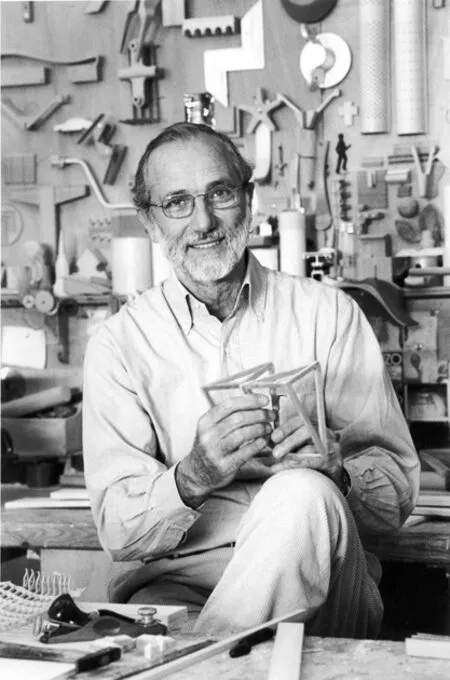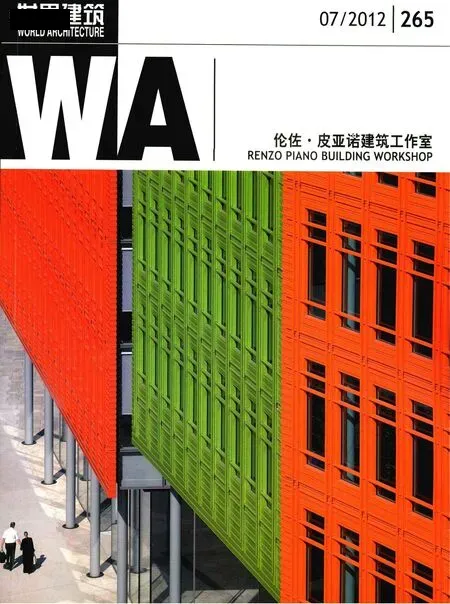1998年普利兹克奖获奖感言
伦佐·皮亚诺/Renzo Piano
孙晨光 译/Translated by SUN Chenguang

伦佐·皮亚诺
1937年出生于热那亚的建造商家庭。1964年从米兰理工大学建筑学院毕业之后,他开始尝试轻型、可移动的临时建筑方面的实验。1981年,他成立了伦佐·皮亚诺建筑工作室,目前在巴黎、热那亚和纽约设有办公室。
曾获主要奖项:英国皇家建筑师协会金奖(1989年),日本京都奖(1990年),普利兹克建筑奖(1998年),意大利建筑设计金奖(2003年),美国建筑师协会金奖(2008年),哥本哈根森宁奖(2009年)。□
总统先生,克林顿女士,普利兹克先生和夫人,获得1998年普利兹克建筑奖对我来说是无比荣幸的事情,首先我要感谢评审团的所有成员,他们对评审工作极其负责,让普利兹克奖向那些像我一样身处奖项“神庙”之外的人敞开了大门。
被提名为年度建筑师,我非常高兴、自豪和欣喜,无论这将会意味着什么,这的确听起来有点奇怪:就像“年度热卖”、“当季最佳”、“月度冠军”之类的,是不是这就意味着建筑师也有保质期,等到年末的时候就会被抛弃掉?
但是,建筑师到底是什么呢?建筑又是什么呢?我已经入行30年了,而直到现在我才开始明白建筑究竟意味着什么。首先,从最表面的字面意思看,建筑业是一种服务。它是一种为了某种用途而进行创造的艺术,也是一种具有社会危险性的艺术,因为这是一种强势的艺术。你能放下一本劣质的书,也能不听那些不好听的歌曲,但是你却无法无视那些就在你房子对面的丑陋的塔楼。建筑强加给人们的丑陋,甚至让人没有机会进行选择,无论是对于现在还是未来,建筑都有一个严肃的责任。建筑师是一个古老的职业,甚至也许是世界上最古老的职业,或者说是第二古老的职业,就像打猎、捕鱼、耕作或者海上探险一样。相比其他职业,这些都是人类最初的活动。在寻找食物之后,紧接着人们就开始寻找遮蔽的住所,后来人们就不再栖居于自然提供的遮蔽之下,而形成了建筑师这个职业。
最后,建筑是多元事物的集合:历史学、地理学、人类学和环境学、科学和社会学,建筑不可避免地反映了所有这些学科。
也许通过这样一幅画面能够更好地解释我的观点:建筑就像一座冰山一样,当然并不像“泰坦尼克号”那样一旦撞上就会让你沉没的那种冰山,而是指冰山余下的部分都浸没隐藏在水中。冰山的7/8都浸没在水中,而我们就是要找到把建筑这座冰山中隐没的力量,把社会、科学和艺术这些印象因素充分结合。
建筑就是社会,不能脱离人、人的希望、努力和激情而存在。倾听人们的声音非常重要,这对于建筑师尤其困难,因为强加个人的设计、个人的思考方式,甚至是个人的风格总是充满诱惑。而我认为,轻度的设计才是适宜的,所谓轻度,并不是要放弃那些让你推进方案的动力,而是让你去倾听别人的意见。
我并不是童子军,我对于建筑服务意义的观点并非意在说教,而只是出于对职业尊严的倡议。失去了这种尊严,我们就面临着在时尚和流行中迷失自我的危险。把建筑业看成是服务业必然意味着限制和制约了创作的自由,但是谁能说创作一定得有毫无约束的自由呢?我甚至认为,对于社会和社会需要的解读,是建筑的财富:佛罗伦萨是一座美丽的城市,因为它是意大利文艺复兴的缩影,它的艺术家、商人和欣赏艺术的人们,它的街道、广场和宫殿都是洛伦佐·美蒂奇眼中社会的反映。
建筑是一门科学,作为科学家,建筑师必须扮演探索者的角色,敢于冒险,他必须带着好奇和勇气去解决现实问题,去理解和改变现实。建筑师应该是文艺复兴式的一名工匠,想想伽利略,望远镜是为了从轮船向外远眺而发明的,而不是为了观察星体的运动。神学家关注星星,而他却想了解天堂,为了这个追求和那时最有权势的教廷斗争。这对我有很大的启示,给我上了重要的一课:这就是对于新事物的好奇、思想的独立和对于未知事物探索的勇气。
建筑师总是生活在边缘,而且经常需要跨越它们,去看一看那一边有什么。他们也会用望远镜去瞭望那些神圣文字中没有写到的东西。伯鲁乃列斯基不仅设计建筑,也设计建造建筑的机械,安东尼奥·马内蒂详细描述了他是如何学习钟表的机械系统,并把它应用在一个大起重系统中的,这也是大穹顶被升起来的办法。这是一个非常有趣的例子来解释建筑师是如何进行研究的,也启发我们去思考这样一个重要问题:那些我们敬仰为大师的人们,在他们的时代都是伟大的发明家,他们是划时代的,他们用实验和冒险找到了自己的道路。
在解释颁奖原因的时候,评审团把我比作伯鲁乃列斯基,让我倍感骄傲和不安,他是一个永远只能接近而无法到达的榜样。如果一定要我把自己比做什么人,我选择比作鲁宾逊,一个有能力在陌生岛屿上生存下来的探险者。
建筑是一门艺术,用技术来创造情感,建筑有一套自己的语言,组织空间、光线和材料,而其中有一个要素对于我是非常重要的:光线。在我早期的作品中,那就是一个游戏,一个非常幼稚的对于无形空间和结构的挑战,后来,这成为了我做建筑的一种方式。在我的建筑中,我尝试使用一些非物质的元素,比如透明度、光线、光线的变化。我相信这些和建筑的形体和体量具有同样重要的地位。
就像所有艺术一样,创作都有困难的时刻,创造意味着在黑暗中攫取,在参考中迷失,面对未知的领域。要坚强、要顽强,缺少了这些品质,你就只能在创造之外徘徊。思想的探险结束了,取而代之的是学院派的僵化。
为了真正地创造,建筑师需要面对这个职业的所有矛盾:约束和自由的矛盾、记忆和创造的矛盾、自然和技术的矛盾,这些矛盾无法被逃避,如果生活是复杂的,那艺术就更加复杂。建筑是社会、科学和艺术的结合体。就像冰山,是数千年积累形成的结果,是一个在不断变化的形体,冰不断地在很多海洋中融化和冻结。
建筑是生活的一面镜子,这就是为什么我在建筑中看到的第一事情是好奇、社会化和对于探险的欲望,这些是让我一直被挡在建筑的神庙外的原因。我出生在一个建造商的家庭,这给了我一种和建造艺术之间的特殊关系。我总爱和父亲一起到建筑工地上,看人们用双手从无到有的创造。对一个孩子来说,建筑工地有一种魔力:今天能看到一堆沙子和砖头,明天看到一堵立起来的墙,而最后这些都变成了人们能居住的高大坚固的建筑。我是一个幸运的人,我的生命正是在做我小时候梦想的事情。
1945年我7岁的时候,战后的重建奇迹刚刚开始。以进步和现代的名义,很多愚蠢的东西被宣扬和建造。但是在我的年代,世界的这种“进步”的确意味着一些事情,每一年这些进步都把我们从战争的阴影中一点点带离,我们的生活也看上去一天天变得更好。在那个时代成长起来意味着对未来有着乐观的信念。
我属于这样一代人,他们在生命中不断尝试来探索不同领域,而忽视规则的界限,他们给规则洗牌,敢于冒险和犯错。在很多领域,比如戏剧、绘画、电影、文学和音乐中都是这样,甚至和文化背景无关。文化成为了一个可以消失的碎片,这些都让你本能地乐观成长,而相信未来,这是自然而然的。但是同时,你也会热爱过去,生活在对过去的感恩和对探索未来的热情中间。
我想起了弗·司各特·菲茨杰拉德的《了不起的盖茨比》里面结尾的一句话“于是我们奋力向前划,逆流向上的小舟,不停地倒退,进入过去。”这是一幅辉煌壮丽的画面,是人类现实的象征。往昔是一个安全的庇护所,是持续不断的诱惑,但是如果我们不得不去什么地方的话,未来是我们唯一能去的地方。□
Renzo Piano
Born in Genoa in 1937, Piano comes from a family of builders. Following his graduation from Milan Polytechnic Architecture School in 1964, he started experimenting with light,mobile,temporary structures. He formed Renzo Piano Building Workshop in 1981, which now has offices in Paris,Genoa and Newyork.
Major awards: the Royal Gold Medal at RIBA(1989), the Kyoto Prize in Japan(1990), the Pritzker Architecture Prize (1998), the Gold Medal of Italian Architecture (2003), the Gold Medal AIA (2008) and the Sonning Prize in Copenhagen (2009).□
Mr President, Mrs Clinton, Mr and Mrs Pritzker,it is naturally a great honour for me to be awarded the 1998 Pritzker Prize. And first of all I would like to thank the members of the jury. They have taken on a tremendous responsibility in opening the doors of the temple to someone like me who has always lived outside of it.
I am very happy, proud and grateful to have been nominated architect of the year-whatever that means. It does sound a bit odd, this year's best-seller, the season's hit, the record of the month. Does this mean that architects have a sellby date; that you throw away the architect at the end of the year?
But what exactly is an architect? What is architecture? I have been in this trade for thirty years and I am only just beginning to understand what it is. Firstly, architecture is a service, in the most literal sense of the term. It is an art that produces things that serve a purpose. But it is also a socially dangerous art, because it is an imposed art. You can put down a bad book; you can avoid listening to bad music; but you cannot miss the ugly tower block opposite your house. Architecture imposes total immersion in ugliness; it does not give the user a chance. And this is a serious responsibility -for now and for future generations. And architecture is an ancient profession, perhaps the world's oldest; or the second oldest if you prefer, a little like hunting,fishing, farming, exploring the seas. These are man's original activities from which all others stem.Immediately after the search for food, we find the search for shelter; at a certain point, man was no longer content with the refuges offered by nature and became an architect.
Finally, architecture mixes things up: history and geography, anthropology and the environment,science and society. And it inevitably mirrors all of them.
Perhaps I can explain myself better with an image. Architecture is like an iceberg. Not in the sense of the Titanic, that will take you down if you bump into it, but in the sense that the rest is submerged and hidden. In the seven eighths of the iceberg that lie below water, we find the forces that push architecture up, that allow the tip to emerge:society, science and art.
Architecture is society, because it does not existwithout people, without their hopes, aspirations and passion. Listening to people is important. And this is especially difficult for an architect. Because there is always the temptation to impose one's own design, one's own way of thinking or, even worse,one's own style. I believe, instead, that a light approach is needed. Light, but without abandoning the stubbornness that enables you to put forward your own ideas whilst being permeable to the ideas of others.
I am no boy scout, and my appeal to the sense of service is not intended as moralistic. It is, very simply, an appeal to the dignity of our profession.Without this dignity, we risk losing ourselves in the labyrinth of fads and fashions. Reading architecture as a service certainly means limiting its creative freedom, constraining it. Yet whoever said that creativity had to be free of any constraint? I would like to say more: the interpretation of society and its needs is the richness of architecture. Florence is beautiful because it is the image of Renaissance Italy, its artisans, its merchants, its patrons of the arts. Its streets, squares and palaces reflect Lorenzo de’ Medici's vision of society.
Architecture is science. To be a scientist, the architect has to be an explorer and must have a taste for adventure. He has to tackle reality with curiosity and courage to be able to understand it and change it. He has to be a "homo faber",in the Renaissance sense of the term. Think of Galileo: the telescope was invented to look out for ships, certainly not to study the movement of the stars. Theologians worried about the stars. He,instead, wanted to understand the heavens, and he fought against the most powerful lobby of his time to do it. This image represents a lot for me: a formidable lesson in curiosity for anything new, an independence of thought and courage in exploring the unknown.
Architects have to live on the frontier, and every so often they have to cross it, to see what is on the other side. They, too, use the telescope to look for what is not written in the sacred texts.Brunelleschi did not just design buildings, but also the machines to build them. Antonio Manetti recounts how he studied the mechanism of the clock in order to apply it to a system of large counterweights: this was how the structure of the cupola was raised. This is a lovely example of how architecture is also research. And it makes us think about an important thing: all of those whom we look up to as "classics", were in their own time great innovators. They were the cutting edge. They found their way by experimenting and taking risks.
In explaining their reasoning in assigning this prize, the jury makes a reference to Brunelleschi which fills me with pride and embarrassment at the same time. He is a model that cannot be reached,but only approached. If I have to compare myself to someone, I prefer Robinson Crusoe, an explorer capable of surviving in foreign lands.
Architecture is an art. It uses technique to generate an emotion, and it does so with its own specific language, made up of space, proportions,light and materials (for an architect, matter is like sound for a musician or words for a poet). There is one theme that is very important for me: lightness(and obviously not in reference only to the physical mass of objects). At the time of my early works, it was a game, a rather naive challenge of shapeless spaces and weightless structures. Later, this became my way of being an architect. In my architecture,I try to use immaterial elements like transparency,lightness, the vibration of the light. I believe that they are as much part of the composition as the shapes and volumes.
And like in all arts there are difficult moments.Creating means grasping in the dark, abandoning points of reference, facing the unknown.Tenaciously, insolently and stubbornly. Without this stubbornness, which I find sublime at times, you remain outside of things. The adventure of thought comes to an end and academia begins.
To be truly creative, the architect has to accept all the contradictions of his profession:discipline and freedom, memory and invention,nature and technology. There is no escape. If life is complicated, then art is even more so.Architecture is all of this: society, science and art. And like the iceberg, it is the result of stratification that lasts thousands of years. Like the iceberg, it is a continuously changing mass, with the ice melting constantly and reforming in the water of the many oceans.
Architecture is thus the mirror of life. This is why the first thing I see in it is curiosity, social tension, the desire for adventure. These are things that have always kept me outside the temple. I was born into a family of builders, and this has given me a special relationship with the art of "doing". I always loved going to building sites with my father and seeing things grow from nothing, created by the hand of man. For a child, a building site is magic:today you see a heap of sand and bricks, tomorrow a wall that stands on its own; at the end it has all become a tall, solid building where people can live.I have been a lucky man: I have spent my life doing what I dreamt as a child.
I was seven years old in 1945, when the miracle of post-war reconstruction began. In the name of progress and modernity, a lot of stupid things have been said and done. But for my generation, the word “progress” really meant something. Every year that went by took us further from the horrors of war and our life seemed to improve day by day. Growing up in that period meant having an obstinate belief in the future.
I belong to a generation of people who have maintained an experimental approach throughout their life, exploring different fields, ignoring boundaries between disciplines, reshuffling the cards, taking risks and making mistakes. And in many different fields. From theatre to painting,cinema, literature and music. Without ever talking about culture. Culture is a fragile term which can disappear like a will-o-the-wisp just when you call it up. This all makes you grow up instinctively optimistic and makes you believe in the future. It is inevitable. But at the same time, you love your past (as an Italian, or, rather, European, you have no choice). And so you live in a limbo between gratitude towards the past and a great passion for experimentation, for exploration of the future.
The final words of Francis Scott Fitzgerald'sThe Great Gatsbycome to mind: "so we beat on, boats against the current, borne back ceaselessly into the past." I find this a splendid image, an emblem of the human condition. The past is a safe refuge. The past is a constant temptation. And yet the future is the only place we have to go, if we really have to go somewhere.□

